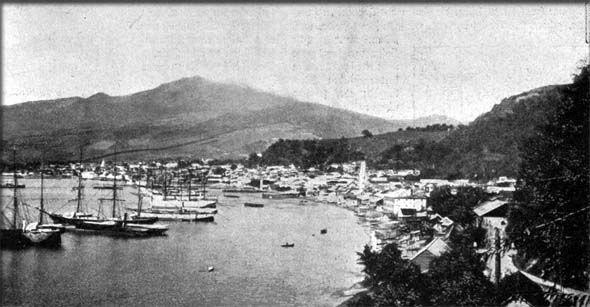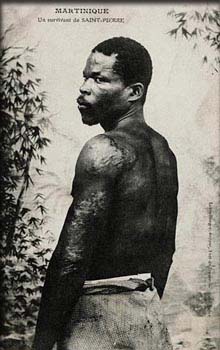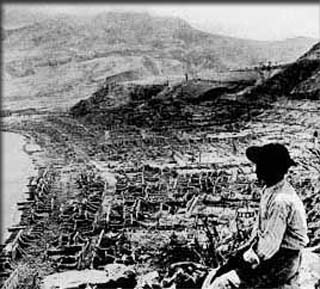The Man
Who Lived Through Doomsday
|

The
City of Saint-Pierre, with Mount Pelée behind it, shortly
before the volcano awoke in 1902.
|
Early
on the morning of May 8th, 1902, the city of Saint-Pierre, located
on the French Caribbean island of Martinique, was destroyed
by an eruption of Mount Pelée. At 7:52 AM, a blast from the
volcano sent a pyroclastic flow down into the city of 30,000,
killing the entire population. Well, everybody but one man:
Ludger Sylbaris, who became known as the man who lived through
Doomsday.
By the
end of the 19th century, the city of Saint-Pierre was a bustling,
beautiful place, often referred to as the "Paris of the West
Indies." Founded in 1635 by Pierre Belain d'Esnambuc, a French
trader and adventurer, it was the first permanent French colony
on Martinique. By the beginning of the 20th century it was the
largest city on the island.
Behind
the city, however, towered the peak of Mount Pelée. With an
elevation of 4583 feet (1,397 m), it dominated the skyline of
the town which was only four miles from the summit of the mountain.
|

Ludger
Sylbaris became known as the "Man Who Lived Through
Doomsday."
|
The
Sleeping Volcano Next Door
Though
the citizens of Saint-Pierre were aware that the mountain next
door was a volcano, it had been largely quiescent during the
history of the town. The last volcanic event had been a minor
phreatic (steam) eruption that occurred in 1851 that was not
within the memory of most of the inhabitants by 1902. Only the
appearance and disappearance of the occasional fumarole (steam
vent) reminded the population of the nature of the peak. This
started to change in the summer of 1900, however, when loud
groaning could occasionally be heard from inside the mountain.
Still,
there was little concern until April 23 of 1902. On that day,
a series of sharp, underground shocks startled the residents
of the town. Up on the mountain, a light rain of cinders fell
on its southern and western slopes. Two days later, a large
cloud containing rocks and ashes appeared from the crater at
the top. While the appearance of this produced some concern,
only minor damage was caused by the event. The next day, however,
the town found itself dusted by a light layer of ash.
This
prompted several people on April 27th to climb the mountain
and see what was going on at the top. When they reached the
crater, they found it filled with water, creating a lake 590-feet
across. Located on one edge of this new lake was a 50-foot-high
cone of volcanic debris. From the cone flowed a steady stream
of boiling water and the air was strong with the smell of sulfur.
These
changes caused concern in the city, but it was felt that the
main danger to the town would be from lava flows. However, it
was thought that these would be blocked and diverted by the
valley that lay between the mountain and the town.
Late
in the evening on May 2nd, the mountain rocked the city with
a series of loud explosions and earthquakes that lasted almost
6 hours. A massive pillar of dense, black smoke poured from
the crater. Streams began to fill with dust and debris, killing
livestock in the area that depended on the water to survive.
|

What
remains of the life saving prison cell today. (CC
BY-SA 3.0 courtesy Riba)
|
By Sunday,
a number of the city inhabitants were so concerned that they
decided to leave the area and steamers bound for other parts
of the island were packed full. Still, this was a minority of
the population and in fact the number of people in the town
actually grew as those residing in many of the rural villages
in the area fled to the town, which was considered "safe."
On Monday
morning the mountain seemed to become calm, but by the afternoon
another worry beset the city dwellers: the sea. The ocean had
mysteriously receded 300 feet, then rushed back with a vengeance,
flooding low-lying areas. Then, up on the mountain, the side
of the crater collapsed and out poured a mixture of boiling
water and mud (called a lahar) that flowed into the Blanche
River. The lahar flooded the Guérin Sugar Works outside the
city and buried 150 victims under hundreds of feet of mud.
On May
7th the mountain's activity seemed to peak: clouds of ash poured
from the crater, causing bolts of volcanic lightning to strike
around the mountaintop. As it grew dark, the crater glowed with
a reddish-orange light. The authorities in the city and the
newspapers insisted that the town was safe and the volcano was
just relieving internal pressure. Not reassured, many fled the
town, but even more people entered it as refugees from the countyside.
The
Life Saving Prison Cell
That
night, a farm worker named Ludger Sylbaris, who was frequently
in trouble with the authorities,
got into a drunken fight and by some accounts, nearly caused
a riot. Police decided to throw him into solitary confinement
and he was locked in a small, stone-walled, partially-underground
cell with no windows and only a small vent in the metal door.
|

What
remained of the city shortly after the disaster.
|
According
to Sylbaris, at around breakfast time the next day, it grew
very dark and suddenly hot air mixed with fine ashes rushed
into the cell from the small grating in the door. He pulled
his clothes off, urinated on them and stuffed them into the
vent to block the heat. Despite his efforts, the temperature
shot up in the cell until it felt like and oven and Sylbaris
suffered extensive burns.
What
had caused the sudden heat? Outside, the side of the volcano
had suddenly been blown out and a mass of hot gas and volcanic
material, called a pyroclastic flow, raced down the mountain
at an estimated speed of 420 mph (670 km/h). With a temperature
of over 1,800 °F (1,000 °C), it set anything combustible on
fire and either burned and/or suffocated virtually the entire
population of the city.
Why
had the authorities thought the city was safe? Pyroclastic flows
were not well understood at the time, even though a similar
one had doomed ancient Pompeii in 79 A.D.. Those in charge thought
the main danger was from slow-moving lava flows, which they
thought would be blocked from the town by a hill. The pyroclastic
flow, however, was moving so fast that it simply climbed topped
the hill and flowed into the city, utterly destroying it and
the 30,000 to 40,000 people who were living there or sought
refuge there.
While
a few people who were on the edge of town survived, Sylbaris
was the only person in the center of the city who avoided a
horrible death. Four days after the disaster, a relief crew
heard him calling from his cell and rescued him. Given the circumstances,
Sylbaris was pardoned of his crimes and later found fame and
job security touring America with the Barnum & Bailey's circus,
recounting the horrors of that day under the title of "The Man
Who Lived Through Doomsday."
Mt.
Pelee now sleeps again.
|

Copyright Lee Krystek
2019. All Rights Reserved.